While the LRWP and other New Jersey non-profits are working hard to clean up our waters and secure clean, safe drinking water for future generations, EPA Administrator Scott Pruitt is working to roll back the Clean Water Act. The current administration is rushing through a repeal of the Clean Water Rule and we have until August 28 during public comment to try and stop it. It’s critical for your voice to be heard in D.C.
What is the Clean Water Rule?
In 2015, the previous administration clarified and finalized protections for streams and wetlands across the country. These safeguards protected the small streams that feed the drinking water sources for nearly 1 in 3 Americans. They protected wetlands throughout the nation that filter pollutants from water, absorb floodwaters, and provide habitat for countless wildlife. In fact, industry and other permittees asked for this clarification as an end to regulatory confusion about which of the country’s waterways the Clean Water Act protects. The rule was supported by millions of Americans.
The Clean Water Rule followed a robust public process. Before finalizing the Clean Water Rule in 2015, EPA held more than 400 meetings with stakeholders across the country and published a synthesis of more than 1,200 peer-reviewed scientific publications, which showed that the small streams and wetlands the Rule safeguards are vital to larger downstream waters.
What is this administration proposing?
Administrator Pruitt does not want to implement the Clean Water Rule. Instead, he plans to rush through the repeal of the Clean Water Rule this year, then propose and finalize a less protective rule in less than a year. President Trump signed an Executive Order instructing the EPA to propose a new rule based on former U.S. Supreme Court Justice Scalia’s opinion of which waterways the Clean Water Act protects. A rule following Scalia’s interpretation would result in drastic exclusions of wetlands and streams from protection; fewer than half of wetlands and fewer than 40 percent of streams would receive federal protection. If that scenario comes to pass, then the nation’s waters will be less protected than they were in 1975!
Who is opposing the Clean Water Rule?
Lobbyists for oil and gas producers, homebuilders, and farm bureaus.
What is at stake?
Our right to clean drinking water is in jeopardy. Rolling back the rule will result in the same regulatory confusion that resulted in broad-based calls for clarity about which of our nation’s waterways the Clean Water Act protects. Rolling back the rule is bad governance, bad for businesses who rely on regulatory certainty, and bad for our communities that deserve clean water.
How you can help
The LRWP has submitted this letter (8.16.17 – LRWP letter to EPA re CWA rules repeal) to Administrator Pruitt. You can help by submitting a request to stop the repeal of this important rule on or before Monday, August 28, 11:59pm EST. Submit your online comment to the Federal eRulemaking Portal to STOP THE REPEAL! Sample language below:
RE: Docket ID No. EPA-HQ-OW-2017-0203
Dear Administrator Pruitt:
The last thing we should do is weaken protections for clean water. I oppose the proposed repeal of the Clean Water Rule. Let the courts do their jobs and review the 2015 rulemaking.
This roll-back is dangerous. Clean water is the backbone of healthy communities and essential to a strong economy. Repealing this commonsense safeguard puts all of that at risk. The proposed repeal will remove Clean Water Act protections for the streams that feed the drinking water sources for more than 1 in 3 Americans. It will endanger 20 million acres of wetlands that provide habitat for wildlife throughout the nation. It could allow the pollution and destruction of the water resources small businesses like craft breweries and outdoor recreation companies rely on. Moreover, property values would be negatively impacted.
Repealing the Clean Water Rule is shortsighted and flies in the face of public opinion. More than 800,000 Americans supported the Clean Water Rule when it was proposed. It is grounded in science and the law. It is an essential tool to help us to get to goal of ensuring all of our waters are swimmable, fishable, and drinkable.
[Include your own thoughtful, compelling comment of how clean water is important to you]
Please stop the repeal process and get back to EPA’s mission – protecting human health and the environment.
Thank you for considering my concerns.
Sincerely,
[your name]
Lower Raritan Watershed, New Jersey
Article and photos by Joe Mish
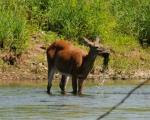

Dining at the underwater salad bar, this deer enjoys more than a mouthful of greenery, obtained by submerging its face in the water up to its ears.
August is a deep relaxing stillness in the never-ending cycle of renewable life. It is the moment after the final brush stoke is applied to an artistic masterpiece. Work that began anew, a year before, has reached a higher level of maturity in an infinite succession of seasonal effort.
The terminal end of each season can be a time of reflection, as an endpoint immediately prompts the thought of a beginning. August, however, is different, as there is an aura of timelessness created in an extended moment of satisfying exhalation; an arrival after a long journey.
Time is now suspended by desire. August is the moment we want to last. There is no desire for summer to end or feel the chill of winter sooner than scheduled. Mentally we drag our feet to slow the calendar, even assigning 31 days isn’t enough, and in response, time accelerates.
While the berries harvests of June and July have gone by, the plants that sent their energy to the fruit, now direct it to the roots and leaves in preparation for next berry season. The berry season may have been the highpoint for berry consumers but for the blackberry or dewberry plant, August is a finish line in a race to recover and maximize growth for next year’s crop.
The dark green leaves and vegetation, that dominate the high summer landscape, are noticeably different than the array of green tints seen in the spring. It is as if colors went through a maturation process independent of natural influences. Where the palest greens began to darken in color, as each successive tint accumulated, until it reached a deep forest green.
The summer greenery is not limited to plants and leaves dancing in the wind. Beneath the surface of the river, underwater grasses have reached maturity by late summer. In clear shallow water, the fast current animates long strands of flowing grasses, isolated in bundles across sections of sandy river bottom. Dark green grass sways alongside pony tails of Kelly green and gray green grass to cast a hypnotic spell on a passing paddler.
Deer relish these grasses and spend many a high summer day, faces submerged, full to their ears, in an effort to enjoy that cool mixed salad.
Blooming raspberry colored thistle, topped with flocks of hungry yellow goldfinch, teasel, goldenrod, strands of deep purple pokeweed berries and off-white Queen Anne’s lace, act as colorful bejeweled timepieces set among the greenery of August. Listen closely and you can even hear the ticking of that seasonal clock as black walnuts begin drop. The ticking is especially loud and shocking when a plum sized black walnut falls into quiet water on a calm, windless day, to spike a paddler’s heart rate.
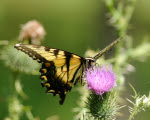
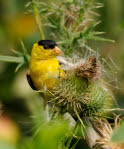
Goldfinch and tiger swallow-tail feed on the blooming thistle of late summer.
August can hardly keep a secret as it reveals a preview of things to come. Look closely and you can find isolated flashes of red and orange staghorn sumac, poison ivy and Virginia creeper. Even if you miss the visual clues, August provides an occasional chilly morning as a reminder that its moment of stillness is just an illusion.
The gold of August is revealed by its first two letters, au, the symbol for gold and awarded for achievement. The ‘gust’ or gusto represents the vigor of mature life that peaks in high summer.
Author Joe Mish has been running wild in New Jersey since childhood when he found ways to escape his mother’s watchful eyes. He continues to trek the swamps, rivers and thickets seeking to share, with the residents and visitors, all of the state’s natural beauty hidden within full view. To read more of his writing and view more of his gorgeous photographs visit Winter Bear Rising, his wordpress blog. Joe’s series “Nature on the Raritan, Hidden in Plain View” runs monthly as part of the LRWP “Voices of the Watershed” series. Writing and photos used with permission from the author.
Article and Photos by Michele Bakacs
Ahoy There Matey! Rutgers Environmental Stewards Take Their First Boat Trip on the Raritan River
On May 3rd the Middlesex class of Rutgers Environmental Stewards took the water. This afforded them a rare opportunity to see the Raritan River up close by taking a 2 hour boat trip on the new R/V Rutgers. The R/V Rutgers is a new boat operated by the Department of Marine and Coastal Sciences. This 36 ft. (11 meter) aluminum landing craft is a 20 passenger vessel and supports a wide range of educational and scientific needs such as trawling, grab sampling, diving, water profiling, coring, AUV operations, etc. Faculty can reserve the vessel so students can get a first-hand look at the Raritan River ecosystem and the human impacts to the watershed.
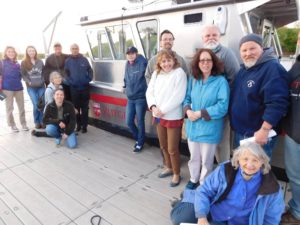
This is part of a larger effort by the Rutgers Collaborative for Research and Education to “Bring the River to your classroom” and works to support faculty efforts in engaging students and the community in Raritan River data and science through data activities.
The Rutgers Environmental Stewards program trains volunteers on important environmental issues affecting New Jersey and helps them make a difference in their own communities. The program consists of 60 hours of classes offered around the state on topics including habitat protection, climate change, geology, soil health, alternative energy, invasive plants, environmental policy, pollinators, and much more. Stewards complete a 60 hour internship of their choosing in order to become certified. Optional field trips are included. Anyone can become an Environmental Steward regardless of background.
The Stewards met the boat in Boyd Park in New Brunswick at the Class of 1914 Boathouse and were welcomed by the boat’s captain Chip Haldeman, and first mate Nicole Waite. Joining us on our trip was Dr. Heather Fenyk, Director of the Lower Raritan Watershed Partnership, and Dr. JeanMarie Hartman, Professor in the Department of Landscape Architecture. Heather and JeanMarie provided a rich history of the Raritan and identified points of interest including shale outcrop geologic formations, the Lenape Trail connection to the River, noted flora and fauna, as well as the industrial legacy of contaminated sites, old factories, and the Edgewater Landfill.
First mate Nicole taught the Stewards how researchers monitor water quality and trained them on collecting data using YSI water monitoring probes to test for dissolved oxygen, pH, temperature, and salinity. We also saw 2 Bald Eagles, countless Ospreys, Cormorants, and vast marshland. The salt marshes are mostly dominated by Phragmites australis, an invasive grass known as Common Reed, but we also saw native Spartina alterniflora (Salt Marsh Cordgrass) holding its own at the fringes of the saltmarshes.
Overwhelmingly the Stewards walked away with a new appreciation of this fantastic natural resource that most of us take for granted. Most people see the Raritan River as a place to avoid, to view from afar from the Garden State Parkway or Route 1 Bridge. This experience helped the Stewards better understand the River that lies in the heart of their community, and the importance of making sure it is cleaned up and protected.
Keep an eye on the LRWP blog for information about how to register for the Rutgers Environmental Steward class of 2018!
Drawing and article by Maya Fenyk (age 13)

Short-Nosed Sturgeon
Hi! I’m Acipenser Brevirostrum, but you can call me Simon the Sturgeon. I am here to tell you about the many challenges I face as a two year old, juvenile short nosed sturgeon in the Raritan River. To start, I’d like to say how glad I am to be a sturgeon in 2017, even though my species has been federally endangered since 1973. Being a sturgeon living 120-150 years ago was even worse. Between the years 1870 and 1900, sturgeon were hunted for meat, but especially prized for their eggs for caviar.
We were nearly driven to extinction! Sturgeon are still feeling the effects 120 years later. Our population is only 12,000 in the waters New York and New Jersey, which truth be told is not a lot as female sturgeons lay 40,000 to 200,000 eggs per year. Caviar and hunting weren’t the only obstacle we have had to swim around to be able to survive. Another issue we face is river pollution. As bottom feeders we have a subterminal snout, we use our snout to vacuum our food from the substrate into our protractile mouth. This means that we pick up a lot of pollutants off of the substrate that isn’t food. We deserve to at least eat our meals of crustaceans, clams, mussels, snails, marine worms, flounder and plant matter, without having to guzzle down chemicals for dessert!
My species is considered a living fossil. We have been around for longer than 12,000 years and have retained a lot of primitive features that were common way back then, like our subterminal mouth and our barbels, a whisker like sensory organ. We have been in this area for longer than humans have, we have survived the caviar craze, and even industrial dumping that was common in Raritan for decades. That dumping residue along with the new stuff that has made its way to the Raritan (like expired medication, fertilizers and pesticides). These can turn into Endocrine System Disruptors (E.S.D) which damage our bodies and can either kill us or make us very sick. A lot of the pollutants also contain cadmium, arsenic are heavy metals that are extremely toxic.
Some ways you can help us live our natural life span of 35-70 years is by making sure to protect us from non-point source pollution. (That’s the pollution that is in stormwater runoff like pesticides, fertilizers, road salts and motor oil). You can make sure that streams have adequate buffers of plants and streams, and cleaning up our habitat will help. Also please let the NJDEP know if you see us. We are brown- gray fish with a yellow underbelly with a short rounded snout, heterocercal tail and a subterminal mouth, that is 18-22 inches long. Now I have to be going I see some yummy algae floating by. Though it isn’t fast food, but it sure moves pretty quick. Simon the sturgeon splashes out!
Dear Friends of the Lower Raritan Watershed –
It may be hard to believe, but many of the shorebirds that stop through the Lower Raritan Watershed have started their southern migration. Keep a look out for sanderlings, black-bellied plovers, red knots, least sandpipers and short-billed dowitchers. Knowing that our avian friends are already on their return trip home is a good reminder to get out in the field and enjoy the summer while it’s here!
We’ll celebrate the last last bit of summer at our next meeting, an after-work picnic on World Water Monitoring Day 2017. Join us in New Brunswick’s Boyd Park on Monday September 18 from 5:30-7:30pm, and bring your own picnic or something to share. We’ll supply beverages, paper products and dessert. Friends and family members welcome! (RSVPs requested). The evening will include water quality monitoring, project updates and a Raritan River “story slam” with coLAB Arts. Do you have a special Raritan River memory? Perhaps you swam in the Raritan as a kid, or have a story from a recent clean-up? Let us know! We are looking for 4-5 people to tell their stories on Sept 18. Storyteller confirms requested by August 31.
See you in the watershed,
Heather Fenyk, President
Lower Raritan Watershed Partnership
Article and photos by Joe Sapia
Note: The yard references are to my house in the section of Monroe between Helmetta and Jamesburg in South Middlesex County. My yard is in a Pine Barrens outlier on the Inner Coastal Plain, the soil is loamy, and my neighborhood is on the boundary of Gardening Zones 6b (cooler) and 7a (warmer). Notes and photographs are for the period covered, unless otherwise noted.
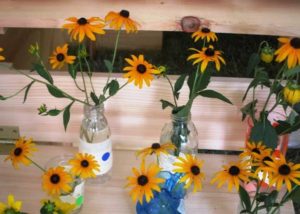
Flowers on display at the Monmouth County Fair, which runs through Sunday, July 30, in Freehold Township.
THE DRIVE-BY NATURALIST, FLICKER: I aim to check the family gravesites once a month, with one of my visits to Saint James Cemetery in Monroe. There, I observed a bird I normally only get a glimpse of, flying off when spooked, the northern flicker, “Colaptes auratus” – in Greek, the genus name referring to “peck” because the flicker is a woodpecker and the species name referring to its “golden” underwing, according to the Texas Parks and Wildlife website. The flicker, whose body is generally tan with black speckles, is easily identifiable when it flies off because of its white rump. The flicker is a year-round resident.

A flicker at St. James Cemetery, Monroe.
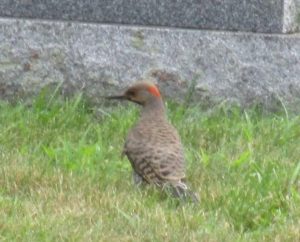
The Saint James Cemetery flicker.
IN THE GARDEN: I picked multi-color carrots and green tomatoes for a salad. A true tomato crop will be iffy because some animal is snipping the tops of the plants. Sweet corn should be ready for picking soon (if the deer or raccoons do not get to it), although I noticed some yellowing of the leaves, probably attributable to the recent wet conditions. The rains apparently caused the splitting of a cantaloupe – basically, the rain forcing the fruit to develop more quickly than it is capable. So, I am backing off on watering at least the cantaloupe. The missing cucumbers are no longer missing; they are fruiting. I thought the tomatillos – which I did not plant and do not know where they came from – were ready for harvest, but they are still developing.

Pick green tomatoes and multi-color carrots from the garden, add balsamic vinaigrette dressing, and, voila, Joey’s Garden Garden Salad.
MY GARDEN WATERING OBSESSION: My two water barrels are pretty full, meaning I have about 50 gallons of non-house water on hand. The water is from various sources, including rainwater and recycled water from the cellar dehumidifier. But, after talking to other gardeners about watering, most recently Diane Larson, the horticulturist at the Rutgers University Cooperative Extension/Monmouth County, I am backing off on my daily watering. Instead of a daily watering, I am going to an every-other-day watering or even a less-frequent watering.
THE DRIVE-BY NATURALIST, KINGBIRD: As I walked around Saint James Cemetery, I noticed a bird I had not observed in years perched on a utility line, the eastern kingbird, “Tyrannus tyrannus.” It, too, is easily identifiable: dark head, white chin and underbelly, a white border to its dark tail. As the Cornell University All About Birds website says, “With dark gray upperparts and a neat white tip to the tail, the Eastern Kingbird looks like it’s wearing a business suit. …The scientific name ‘Tyrannus’ means ‘tyrant,’ ‘despot,’ or ‘king,’ referring to the aggression kingbirds exhibit with each other and with other species.” Here, it is a summer breeder eating insects, migrating to South America to spend winters and mainly eat fruit. An interesting fact, according to All About Birds, “Eastern Kingbirds apparently rely almost completely on insects and fruit for moisture; They are rarely seen drinking water.”

Pick green tomatoes and multi-color carrots from the garden, add balsamic vinaigrette dressing, and, voila, Joey’s Garden Garden Salad.
MY GARDEN WATERING OBSESSION: My two water barrels are pretty full, meaning I have about 50 gallons of non-house water on hand. The water is from various sources, including rainwater and recycled water from the cellar dehumidifier. But, after talking to other gardeners about watering, most recently Diane Larson, the horticulturist at the Rutgers University Cooperative Extension/Monmouth County, I am backing off on my daily watering. Instead of a daily watering, I am going to an every-other-day watering or even a less-frequent watering.
THE DRIVE-BY NATURALIST, KINGBIRD: As I walked around Saint James Cemetery, I noticed a bird I had not observed in years perched on a utility line, the eastern kingbird, “Tyrannus tyrannus.” It, too, is easily identifiable: dark head, white chin and underbelly, a white border to its dark tail. As the Cornell University All About Birds website says, “With dark gray upperparts and a neat white tip to the tail, the Eastern Kingbird looks like it’s wearing a business suit. …The scientific name ‘Tyrannus’ means ‘tyrant,’ ‘despot,’ or ‘king,’ referring to the aggression kingbirds exhibit with each other and with other species.” Here, it is a summer breeder eating insects, migrating to South America to spend winters and mainly eat fruit. An interesting fact, according to All About Birds, “Eastern Kingbirds apparently rely almost completely on insects and fruit for moisture; They are rarely seen drinking water.”
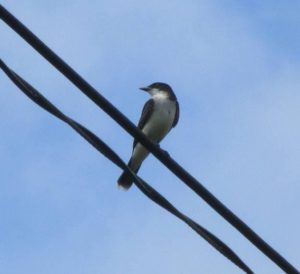
The Saint James Cemetery kingbird.
FALL CROPS: I should get carrots, lettuce, beets, and peas in the ground around August 1, although my tight schedule will probably delay that planting. Around August 15, I am looking to plant spinach.
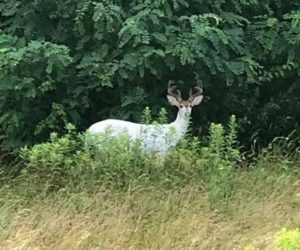
This white-tailed deer, “Odocoileus virginianus,” in a genetic piebald state lives in the Route 130 area of Cranbury, Middlesex County. Thanks to George Nikitiades, whose family owns Teddy’s luncheonette in Cranbury, for passing along this photograph.
THE DRIVE-BY NATURALIST, DEER: As I was driving to the Monmouth County Fair, I passed a soybean field in Monroe and noticed a doe with her two fawns. The good thing for me, I captured some nice photographs. As for the farmer, his or her crops are likely being shared with these deer.
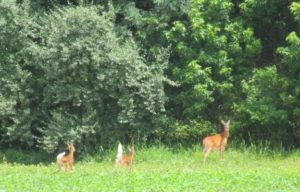
The Monroe doe and her fawns.
MONMOUTH COUNTY FAIR: The Monmouth County Fair, operated by the county Park System, completes its five-day run Sunday, July 30. This fair has a little bit of everything – and I like it because it retains the Old Jersey farm, garden, animal, and home exhibits. I spent some time there with retired county Agricultural Agent Rich Obal, county plant horticulturist Diane Larson, and Master Gardeners judging vegetables, flowers, and herbs. It was good to see Rich, whom I dealt with as an Asbury Park Press reporter over 30 years. And a shout out to Diane, who runs the Master Gardeners program, for continuing to answer my questions over the years.
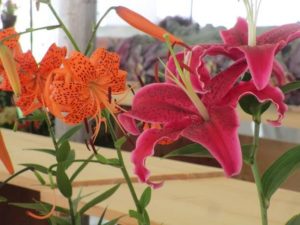
Flowers at the Monmouth County Fair.
QUEEN ANNE’S LACE: Outdoorswoman Priscilla “Peppy” Bath of Hamilton, Mercer County, noted, “The Queen Anne’s lace is outstanding this year. When I was a little kid I would put some stems of Queen Anne’s lace in ink and watch the flowers turn blue.” I, too, have noticed a lot of Queen Anne’s lace, ““Daucus carota,” this year. And, now that Peppy has given me the idea, I will have to go out and buy some food coloring.
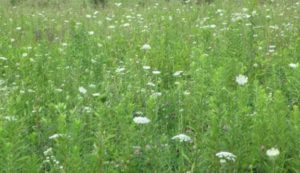
Queen Anne’s lace blooming in a fallow field at Heavenly Farms, East Brunswick, Middlesex County.
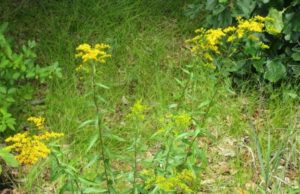
Goldenrod, genus “Solidago,” is blooming along roadsides. Here, it blooms along ConRail railroad tracks in Monroe.
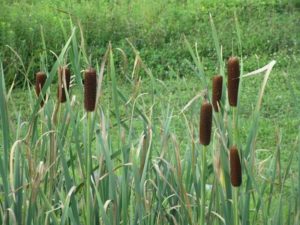
Punks, or cat-tails, genus “Typha,” are in flower in wetlands.. These were photographed at Heavenly Farms in East Brunswick, Middlesex County.
GARBAGE IN THE WOODS: Because of development, destruction caused by off-road vehicle riding, and littering or garbage dumping, we are losing the battle to protect open space. Earlier this month, I came across living room furniture dumped along an East Brunswick, Middlesex County, public road passing through the Jamesburg Park Conservation Area. Middlesex County Parks and Recreation responded and removed the trash. The Jamesburg Park Conservation Area is approximately 1,400 acres of Pine Barrens ecosystem in East Brunswick, Helmetta, Spotswood, and Monroe. It is home to one of the few Atlantic white cedar swamps in the area, along with pine-oak forest, orchids, carnivorous plants, various wildlife (including the carpenter frog, which could be at its northernmost location, here.) See http://www.middlesexcountynj.gov/…/PR/Jamesburg-Park-CA.aspx. It is truly a jewel that needs to be respected, so that future generations can enjoy it, too. I take this personally — My family through my maternal side has walked afield in what is now the conservation area for more than 100 years and I have been a volunteer at Jamesburg Park for years. If anyone recognizes this furniture and knows the owner, please report it to Parks and Recreation, telephone 732-745-3900.
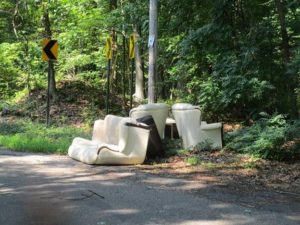
The furniture dumped at the Jamesburg Park Conservation Area.
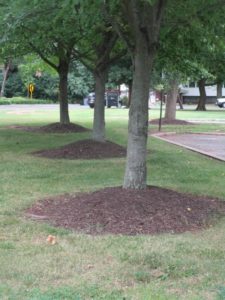
I thought this tree-mulching scene was ironic because it is on Rutgers University’s Douglass-Cook campus. Cook is where Rutgers agriculture studies are based. And these volcano-like mounds are the wrong way to mulch! Creating the volcano-look, or the pileup of mulch against a tree could cause too much wetness around the bark or make the tree susceptible to insect infestation or disease. Instead, use the “doughnut” method of placing the “doughnut hole” outside of the tree and its exposed roots, so the mulch is not touching bark. Outside of the hole, the mulch should be about only 2 or 3 inches in depth, so as not to overwet the tree. The outer rim of the “doughnut” should go to the end of the root ball or the tree canopy/drip line. If a tree is established, there is no need for mulching.

The Northeast Corridor railroad tracks bridge crossing the Raritan River between New Brunswick, left, and Highland Park, right, in Middlesex County. This photograph shows the day’s changing weather, some rain, some sunshine.
PLEIN AIR ART IN THE GARDEN: One night, I plopped myself in a chair at the edge of my garden and used color pencils to do an artwork of the zinnias, which continue to bloom beautifully.

Zinnias in the garden.
OCEAN TEMPERATURES: Atlantic Ocean temperatures on the New Jersey coast were reported at around 75 degrees on Saturday, July 29.
UPCOMING COUNTY FAIRS: Middlesex County Fair, August 7, Monday, to August 13, Sunday, in East Brunswick, http://middlesexcountyfair.com/. Somerset County 4-H Fair, August 9, Wednesday, to August 11, Friday, in Bridgewater, http://www.somersetcounty4h.org/fair/. Hunterdon County 4-H and Agricultural Fair, August 23, Wednesday, to August 27, Sunday.
SUNRISE/SUNSET: For July 30, Sunday, to August 5, Saturday, the sun will rise at about 5:55 to 6 a.m. and set about 8:10 p.m.
WEATHER: The National Weather Service forecasting station for the area is at http://www.weather.gov/phi/.
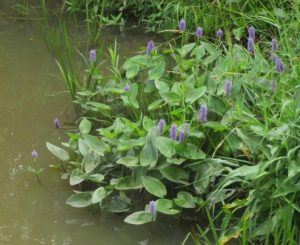
Pickerel weed, “Pontederia cordata,” in bloom on the Millstone River on the boundary of Middlesex County (Monroe and Cranbury) and Mercer County (East Windsor).
Joe Sapia, 60, is a lifelong Monroe resident. He is a Pine Barrens naturalist and an organic vegetable-fruit gardener.
He gardens the same backyard plot as did his Italian-American father, Joe Sr., and his Polish-immigrant, maternal grandmother, Annie Poznanski Onda. Both are inspirations for his food gardening. Joe is active with the Rutgers University Master Gardeners/Middlesex County program. He draws inspiration on the Pine Barrens around Helmetta from his mother, Sophie Onda Sapia, who lived her whole life in these Pines, and his Grandma Annie. Joe’s work also is at @JosephSapia on Twitter.com, along with Facebook.com on the Jersey Midlands page.
Article and photos by Joe Sapia
Note: The yard references are to my house in the section of Monroe between Helmetta and Jamesburg in South Middlesex County. My yard is in a Pine Barrens outlier on the Inner Coastal Plain, the soil is loamy, and my neighborhood is on the boundary of Gardening Zones 6b (cooler) and 7a (warmer). Afield references are to the Pine Barrens around Helmetta, unless otherwise noted. Notes and photographs are for the period covered, unless otherwise noted.
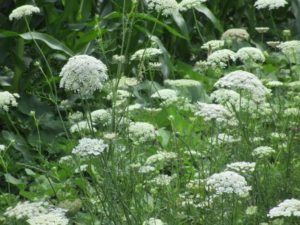
Queen Anne’s lace along a roadside in Monroe, Middlesex County.
THE DRIVE-BY NATURALIST: During the week, I noticed the white-flowered Queen Anne’s lace, “Daucus carota,” blooming along various roadsides. Also, blue-flowered chicory, “Cichorium intybus,” remains in bloom. This got me thinking, how we can observe nature as we drive by. As I try to point out, keep your eyes open – for plantlife and wildlife, along with looking up at the daytime and night skies. Nature is around us, so do not miss out on it. And keep the camera ready!
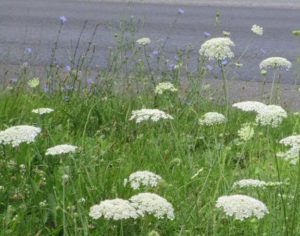
Here, Queen Anne’s lace, the white flower, and chicory, the blue flower, in bloom along a roadside.
ON MY DRIVE-BYS: Despite the warm temperatures during the week, I have been watching for the changing colors of foliage. Yes, it is only July, but the “fall” foliage changing of colors should be starting right about now in the wetlands in the Pine Barrens around Helmetta. I have not seen it yet, but I generally look for changing colors in swamps beginning somewhere in the July 15-to-July 31 period.
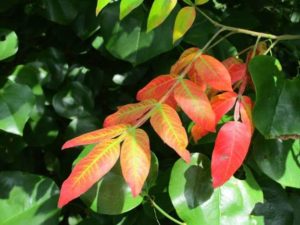
Here, leaves changing colors in 2015, late July, at Cranberry Bog in the Pine Barrens around Helmetta.
SPOTTED ON A DRIVE-BY: As I was putting together this week’s “Garden and Afield,” I shot some last-minute photographs and was driving home when I noticed some deer, “Odocoileus virginianus,” just off the road near Manalapan Brook on the Monroe-Spotswood boundary, Middlesex County. Usually when you see a fawn, Mama is nearby. On this day, though, I caught what I consider an uncommon sight, fawns and a buck (whose antlers were in velvet). Mama Deer was probably keeping an eye on the fawns from nearby in the woods.
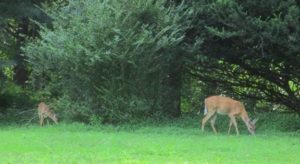
A fawn and a buck in Monroe, Middlesex County.
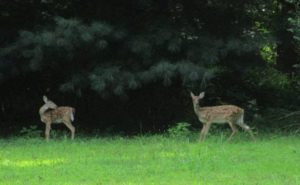
Two fawns in Monroe, Middlesex County.
LOW-MOISTURE-IN-THE-AIR BLUE SKY: Ever notice days when the sky just has that clear look to it? Based on my Roman Catholic upbringing and 16 years in Catholic schools, I call it a “Blessed Mother Blue Sky,” because the sky has the look of the blue clothing associated with the Virgin Mary. Joey Slezak, my go-to science guy in the Pine Barrens around Helmetta, calls it a “Bluebird Sky.” “The first I heard ‘Bluebird Skies’ is (when I was) skiing,” Joey said. “People talking about it. You have white (snowy) ground contrasting the blue sky.” Joey, who has a bachelor’s degree in meteorology from Rutgers University and has completed his master’s degree course work in meteorology at the university, explained the clearness translates as “low moisture” in the air.
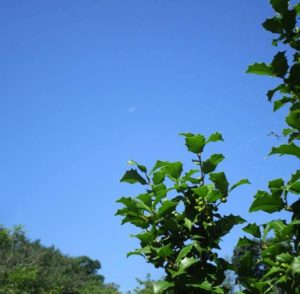
The clear blue sky is a result of low moisture in the air as the moon wanes after the July 8-9 overnight Full Thunder Moon. The next full moon is the August 7-8 overnight Full Red Moon
GARDEN ENEMIES: I have not seen the ground hog and its offspring lately, although the wood steps at one of my house doors is collapsing into their burrow. The rabbits are always around. Then, the other day, I found deer droppings and hoof prints in my garden. Finally, I found the tops of my tomato plants snipped off. Well, there goes this year’s tomato crop….
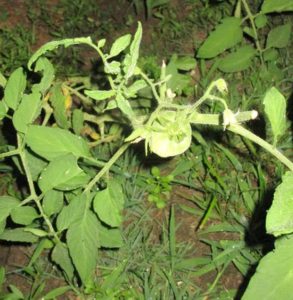
A snipped-off tomato plant in the garden.
WATERING THE GARDEN OBSESSION, NO. 1: On Sunday, July 16, for the first time since planting the food garden around May 20, I was able to water it completely by hand, using water I had accumulated in garbage can reservoirs. I used roughly 30 gallons for the 950-square-foot, or 315-row-feet garden. Now, to replenish the 20-gallon and 30-gallen barrels with rainwater, cellar de-humidifier water, water caputured while sprinkling the garden using the house system, and water from Manalapan Brook. (I keep the barrels covered so as not to promote mosquito development.)
WATERING THE GARDEN OBSESSION, NO. 2: With the water accumulated in my barrels, I thought I could cheat a little, by hooking up a simmer pump and hose to a sprinkler, rather than walking the garden with sprinkling cans. Well, I clogged the sprinkler, which required me unclogging it – but not until I gave up on using the pump for sprinkling. I guess the pump picked up gunk from the water barrel. And I am not even sure the pump was powerful enough to propel the sprinkler properly.
WATERING THE GARDEN, OBSESSION NO. 3 — MANALAPAN BROOK: I grabbed two buckets and took the walk of a few hundred feet to Manalapan Brook, the section between “Jamesburg Lake” (Lake Manalapan) and “Spotswood Lake” (DeVoe Lake). There, I was greeted by my friends, ebony jewelwing damselflies, “Calopteryx maculate.” I waded into the Brook, filled the two buckets, took some photographs, and headed home.
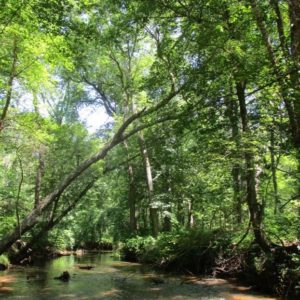
Manalapan Brook in the section of Monroe between Helmetta and Jamesburg, looking downstream toward Helmetta.
ELSEWHERE IN THE GARDEN: I am awaiting cantaloupe/mushmelon and sweet corn, both seemingly behind on the calendar from last year. The tomatillos, which I did not plant, are ready for harvesting; I will pass them along to a co-worker. Otherwise, I had some pea seeds laying around I decided to plant about a week or so ago; They are sprouting.
THE SIZE OF MY GARDEN: Friend, fellow hiker, and fellow gardener Priscilla “Peppy” Bath had an interesting observation about my garden: “Your vegetable garden is so good as you tell about it. I expected it to be much bigger. …Perhaps it would be interesting to others that you do not have one to two acres, but just a normal back yard.” Yes, my yard is only about a quarter-acre. “It would possibly encourage others to make a vegetable garden in their backyards,” Peppy said. I think people do not realize how productive a small garden could be. So, I reached out to friend Diane Larson, who is the home horticulturist and Master Gardener coordinator for the Rutgers University Extension Service office in Freehold, Monmouth County. The Monmouth County Master Gardeners garden is about 40 feet by 50 feet, or about 2,000 square feet. From 2006 to 2016, or over 11 growing seasons, the garden has produced 26,000 pounds of vegetables – an average of about 2,364 pounds per year, all donated to food pantries serving the needy. “The best part, besides all the produce going to food pantries, is that the MGs learn so much out there,” Diane said. “Some have never grown vegetables and they love it.”
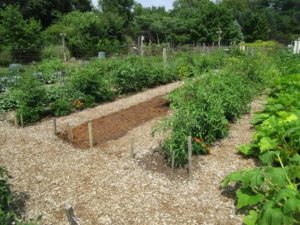
The Monmouth County Master Gardeners garden in Freehold Township. This 40-foot by 50-foot garden has averaged a yield of 2,364 pounds per year from 2006 to 2016, with all the food donated to the needy.

Another view of the Monmouth County Master Gardeners garden.
ZINNIA OBSESSION: My new obsessive-compulsive fascination – the zinnias I planted to attract pollinators to the food garden. For next year, I plan to dig up the front lawn and plant zinnias there, too.
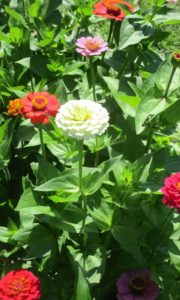
Zinnias in the garden.
FIRE IN THE MAIN PINE BARRENS: A wildfire has burned about 3,500 acres in Wharton State Forest. The fire remained burning as of Saturday, July 22. The good news is the fire — whose cause is, so far, undetermined — is not near buildings, which means the fire, too, will help keep the Pine Barrens a pine barrens. The Pine Barrens is an early succession ecosystem, so the fire – by knocking down the oaks that would shade out the pines – keeps succession in check. The pines may look like burned spars, but they are alive and can regenerate from their trunks, along with root growth and new growth of wildfire-spread seeds; The oaks, on the other hand, cannot regenerate from the trunks, but have to start all over, so to speak, by root growth. On Saturday, the fire was considered “contained,” meaning firefighters had a safe perimeter around it.
ELSEWHERE IN THE YARD: I am slowly reclaiming my yard after 4-1/2 weeks of a major remodeling project on my house – new roof, soffits, gutters and drainpipes, and siding. (For the first time since the house was built in 1952, it is no longer mint green. The retro green has been replaced by barn red.) So, I have been cutting the lawn and trimming shrubs, along with figuring how to approach my neglected garden. And I finally put up the screen tent that has been sitting in a box in my garage for a few weeks. Now, without getting bit by mosquitoes, I can spend warm nights in the screen tent reading, writing, listening to the radio, or just enjoying being outside. Next year, I plan to put the screen tent in a better location, farther from the house, closer to the garden. So, I put up the screen tent and almost immediately it began raining, then monsooning. …Oh, yes, the contractors still have a few odds and ends to finish, but I do have the yard back under my control.
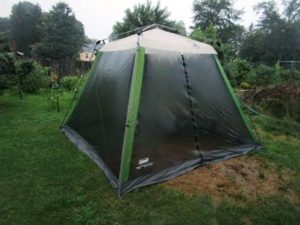
The brand-new, and rain-drenched, screen tent in my backyard.
SOURCES, BOOK NO. 1: One of my book sources is “Dictionary of Plant Names” by Allen J. Coombes, 1985 to 1989, Timber Press. I have had this book for an estimated 25 or more years and have repeatedly turned to it. It lists plants by common and scientific names, cross-referencing the two – for example, mountain laurel, “Kalmia latifolia.” It goes on, saying the genus name is from naturalist Pehr Kalm (who did work in the 1700s in the South Jersey area) and the species name translates from Latin as “broad-leaved.” Mountain laurel, according to the book, is also known as “calico bush.” I use this book both on its own and in conjunction with plant-illustration books.

“Dictionary of Plant Names” by Allen J. Coombes
TURKEY FOLLOWUP: Bob Eriksen, a retired turkey biologist of the state Department of Environmental Protection, made some observations after seeing the photograph of the wild turkeys, “Meleagris gallopavo,” in the Pine Barrens around Helmetta published in the July 9 “Garden and Afield.” Bob said, “Good to see a hen turkey with at least three poults. They are all old enough that they likely will survive to adulthood.”
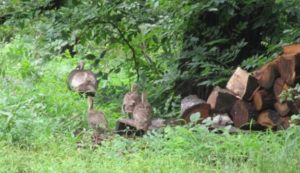
A turkey hen and her three poults in the Pine Barrens around Helmetta, specifically in the Jamesburg Park section of East Brunswick, Middlesex County.
ATLANTIC OCEAN TEMPERATURES: The ocean temperatures have run from about 70 degrees to the lower 80s. On July 18, Tuesday, Glenn “Hurricane” Schwartz, a Philadelphia television Channel 10 meteorologist, said online, “The Atlantic City ocean temperature is now up to 80 degrees. That’s practically unheard of for July. (It) peaks in August. 10 degrees above average.”
UPCOMING COUNTY FAIRS: Monmouth County Fair is July 26, Wednesday, to July 30, Sunday, in Freehold Township, https://www.monmouthcountyparks.com/page.aspx?ID=2492. Mercer County 4-H Fair, July 29, Saturday, and July 30, Sunday, in Hopewell Township, http://mercer.njaes.rutgers.edu/4h/fair/. Middlesex County Fair, August 7, Monday, to August 13, Sunday, in East Brunswick, http://middlesexcountyfair.com/. Somerset County 4-H Fair, August 9, Wednesday, to August 11, Friday, in Bridgewater, http://www.somersetcounty4h.org/fair/. Hunterdon County 4-H and Agricultural Fair, August 23, Wednesday, to August 27, Sunday.
SUNRISE/SUNSET: For July 23, Sunday, to July 29, Saturday, the sun will rise at about 5:50 a.m. and set about 8:18 p.m.
WEATHER: The National Weather Service forecasting station for the area is at http://www.weather.gov/phi/.
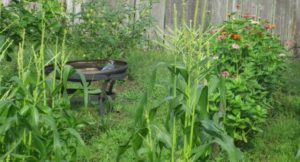
A blue jay rests in the garden, surrounded by sweet corn, tomatillos, and zinnia.
Joe Sapia, 60, is a lifelong Monroe resident. He is a Pine Barrens naturalist and an organic vegetable-fruit gardener.
He gardens the same backyard plot as did his Italian-American father, Joe Sr., and his Polish-immigrant, maternal grandmother, Annie Poznanski Onda. Both are inspirations for his food gardening. Joe is active with the Rutgers University Master Gardeners/Middlesex County program. He draws inspiration on the Pine Barrens around Helmetta from his mother, Sophie Onda Sapia, who lived her whole life in these Pines, and his Grandma Annie. Joe’s work also is at @JosephSapia on Twitter.com, along with Facebook.com on the Jersey Midlands page.
NJDEP – Notice of Rule Proposal
July 17, 2017
Coastal Zone Management Rules, N.J.A.C. 7:7
Freshwater Wetlands Protection Act Rules, N.J.A.C. 7:7A
Flood Hazard Area Control Act Rules, N.J.A.C. 7:13
Proposed amendments, repeals, and new rules
PUBLIC NOTICE
Take notice that the NJ Department of Environmental Protection (Department) is proposing amendments, repeals, and new rules to the Coastal Zone Management Rules in response to issues identified through stakeholder outreach and to address other issues that have arisen since the July 6, 2015 adoption of the consolidated coastal rules. The proposed amendments are related to shellfish aquaculture, filled water’s edge, dune walkovers and other beach and dune development, CAFRA findings, V zones, scenic resources and high-rise structures, permits to apply herbicide, trails, building access in flood hazard areas, application requirements, and rule rationales. Amendments and new rules are additionally proposed in the Freshwater Wetlands Protection Act Rules and Flood Hazard Area Control Act Rules as part of the Department’s continuing effort to align the three land use permitting programs to the extent possible.
The proposal is scheduled to be published in the New Jersey Register dated July 17, 2017. A copy of the proposal is available at http://www.nj.gov/dep/rules/proposals/20170717a.pdf and from LexisNexis free public access to the New Jersey Register, www.lexisnexis.com/njoal.
Public hearings concerning the proposal are scheduled as follows:
Thursday, August 10, 2017, at 6:00 P.M.
City of Long Branch Municipal Building
Council Chambers, 2nd Floor
344 Broadway
Long Branch, NJ 07740
Tuesday, August 15, 2017, at 10:00 A.M.
Campus Center Theater
Stockton University
101 Vera King Farris Drive
Galloway, NJ 08205
Written comments may be submitted electronically by September 15, 2017 at http://www.nj.gov/dep/rules/comments; or in hard copy to:
Gary J. Brower, Esq.
ATTN: DEP Docket No. 11-17-06
NJ Department of Environmental Protection
Office of Legal Affairs
Mail Code 401-04L; PO Box 402
401 East State Street, 7th Floor
Trenton, NJ 08625-0402
Article and photos by Joe Sapia
Note: The yard references are to my house in the section of Monroe between Helmetta and Jamesburg in South Middlesex County. My yard is in a Pine Barrens outlier on the Inner Coastal Plain, the soil is loamy, and my neighborhood is on the boundary of Gardening Zones 6b (cooler) and 7a (warmer). Afield references are to the Pine Barrens around Helmetta, unless otherwise noted. Notes and photographs are for the period covered, unless otherwise noted.
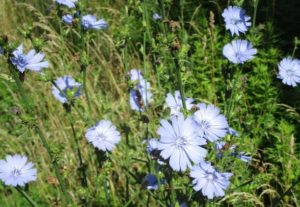
Blooming along a roadside in East Windsor, Mercer County, the beautiful, but non-native, chicory, “Cichorium intybus.”
IN THE FOOD GARDEN: I picked a cherry tomato and some carrots. Otherwise, the garden is between harvesting the early season crop of lettuce and awaiting the warmer weather crop of sweet corn, cantaloupe/mushmelon, and more tomatoes. So, come on pollination – the sweet corn has begun forming tassels (the male flower) and some silk (the female flower), while the mushmelon continues to flower in yellow.
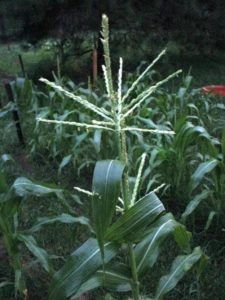
Tassels, or the male flower, on the sweet corn in the garden.
ZINNIA IN THE FOOD GARDEN: Hopefully attracting pollinators to the food garden this year are the score of blooming zinnia of orange, yellow, purple, pink, white, and rose. I have been watching more and more flowers develop this week and, in turn, various pollinators – butterflies, bees, and flies – visiting the zinnia. This is my first year using zinnia, getting the idea from watching pollinators visiting the zinnia at Bobby Laurino’s R.J. Laurino Farms in Colts Neck (www.rjlaurinofarms.com) and Andy Capelli’s Capelli Farms in Middletown (www.capellifarms.com). For next year, I plan to go zinnia-crazy, interspersing rows throughout the food garden and converting more lawn to zinnia growing.
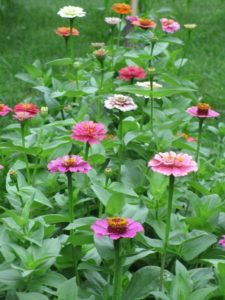
Zinnia in bloom in the garden.
FRUITING IN THE WILDS: Heads up in the wilds, blackberries, genus “Rubus,” should be fruiting here and there. Yes, they are edible – and taste great! From the New Jersey Department of Agriculture, http://www.nj.gov/agriculture/farmtoschool/documents/seasonality-chart/F2S%20Blackberries.pdf.
NEW BRUNSWICK IN FLOWER: I work part-time at Rutgers University’s Jules and Jane Plangere Writing Center at the College Avenue Campus in New Brunswick. But my parking area is cross-town, about 2 miles away at the Douglass College campus. This time of year, especially, I try to walk both ways. The walk gives me a great opportunity to photograph the city of my birth – St. Peter Hospital, Class of 1956. This week, I photographed flowers – white, light pink, dark pink, yellow, red. (Side note: For about half of my 31-year newspaper reporting career at the Asbury Park Press, Mr. Plangere was an owner. Mr. Plangere died in September at 95 years old – but he is still taking care of me!)
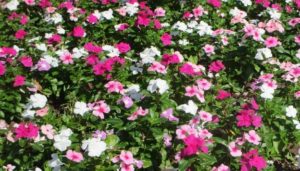
Flowering New Brunswick.
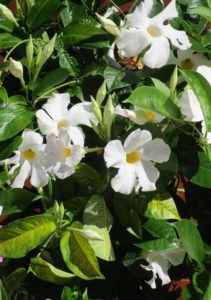
More of flowering New Brunswick.
STARLINGS: Blame these European invaders on lovers of playwright William Shakespeare! According to Cornell University’s All About Birds website, “All the European Starlings (“Sturnus vulgaris”) in North America descended from 100 birds set loose in New York’s Central Park in the early 1890s. The birds were intentionally released by a group who wanted America to have all the birds that Shakespeare ever mentioned. It took several tries, but eventually the population took off. Today, more than 200 million European Starlings range from Alaska to Mexico, and many people consider them pests.”
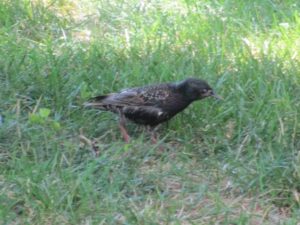
A starling on a New Brunswick lawn.
GARDEN TOOLS: As an only child, I inherited the house I grew up in, moving back to it in 2002. My parents, Joe Sapia Sr. and Sophie Onda Sapia, are the original owners of the house, dating to 1953 and my maternal grandmother, Annie Poznanski Onda, moved in with us in probably 1966. So, basically, three generations have lived here, meaning three generations of “stuff” reside here. When I moved back, I rented a 30-cubic-yard trash bin and cleaned house, except for things that were sentimental and things I figured I could use. So, today, if I need something, before I go out and buy it, I check if I have it around the house or check to see if I can rig something together from what I have around the house. This includes gardening tools. I have a shovel I use frequently and a garden claw for weeding, both with loose handles. A few days ago, I got tired of this loose-handle stuff. So, I used a technique Uncle John Onda taught me when I was a kid: place the item in water, the wood will swell, end of the loose object. I taped the claw and the shovel to the way I wanted the handles positioned, then I put them in my 20-gallon garbage can of gardening water I keep handy. About 36 hours later, I pulled them out – gardening tools that no longer have loose handles. This week, I took another shovel and am doing the same thing.
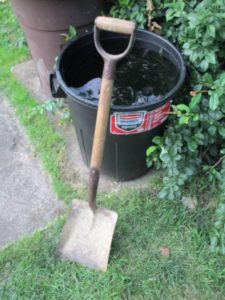
This shovel is about to be soaked in the barrel of garden water.
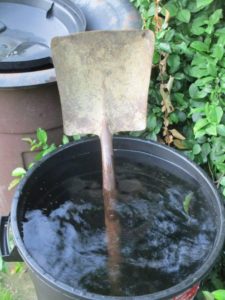
The shovel handle soaking, and swelling, in the barrel of gardening water.
OCEAN TEMPS: Atlantic Ocean water temperatures at the Jersey Shore are running at about 73 degrees to 76 degrees. The average at Sandy Hook for July 16 to 31 should be 71 degrees, according to the National Oceanic and Atmospheric Administration (NOAA).
RIP CURRENTS: This season, you may have seen various warnings of rip currents during television or radio weather reports. Rip currents – also referred to incorrectly as “rip tides” – are currents of water being returned to the ocean from the beach. A rip current dissipates within hundreds of feet, but that is enough time to sweep a swimmer out into the ocean or make it difficult for that swimmer to swim back to the beach against a rip. Basically, there are three things a swimmer can do. One, rips are relatively narrow, so the swimmer can try getting out of the rip by swimming parallel to Shore, rather than back in, until he or she is out of the rip. Two, ride out the rip and, then, swim parallel to Shore and back in. Three, float and signal for help. See NOAA’s advice, http://www.ripcurrents.noaa.gov/surviving.shtml.
WHITE ORCHID IN THE PINES: As its name suggests, the pink lady slipper orchid, “Cypripedium acaule,” generally has a pink flower. But rarely, the flower can be white. During this year’s pink lady slipper blooming season, basically late April-early May into June, outdoorsman Jay Schoss, who is a trustee of the Outdoor Club of South Jersey, found a rare white one in the Whitesbog, Burlington County, area of the Pine Barrens. I have never seen one that I can recall in my 60 years! A great find. (Thanks to outdoorswoman Faye Bray, an Outdoor Club member, for taking the photo and coming through in supplying it. The white variety was “freaking remarkable” and “absolutely beautiful,” Faye said. If you get a chance, take an OCSJ hike led by Jay or Faye. Both are great leaders and great people.)
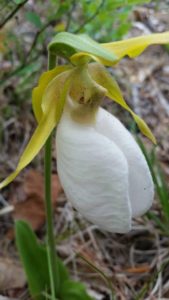
rare white flower of a pink lady-slipper orchid.
LAST WEEK’S DRAGON FLY: Roger Dreyling, a lifelong Jamesburg area outdoorsman and my cousin through marriage, identified the dragonfly I could not identify last week. It is a common whitetail, “Plathemis lydia.”
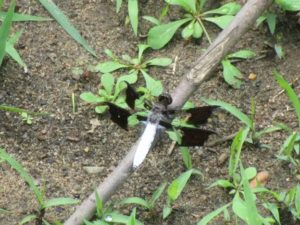
A common whitetail dragonfly in the garden earlier in July.
SUNRISE/SUNSET: For July 16, Sunday, to July 22, Saturday, the sun will rise at about 5:45 and set about 8:25 p.m.
WEATHER: The National Weather Service forecasting station for the area is at http://www.weather.gov/phi/.
NORTHERN LIGHTS: Mass ejections from an explosion at the Sun are to reach Earth Sunday, July 16, possibly enhancing viewing of the Aurora Borealis, or “Northern Lights.” The National Weather Service is saying the Northern Lights may be visible as far south as the Great Lake States and New England. Hmmmm, close enough to us to take a look into the Night Sky on the Sunday-Monday overnight.
I HAVE GOT MY YARD BACK: After almost five weeks of a house-remodeling project (altering the roofline, new roof, new siding, new gutters and drainpipes, and little things here and there), I have reclaimed my yard from the contractors – not totally, because a few odds and ends remain in the coming week or two, but generally. This means, I can get back to some very-needed yardwork – cutting the lawn, trimming the shrubs, and maintaining the garden.
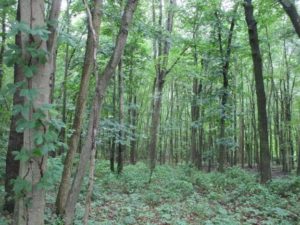
The hardwood forest at Van Dyke Farm, a combination of farm and woods in South Brunswick, Middlesex County.
Joe Sapia, 60, is a lifelong Monroe resident. He is a Pine Barrens naturalist and an organic vegetable-fruit gardener.
He gardens the same backyard plot as did his Italian-American father, Joe Sr., and his Polish-immigrant, maternal grandmother, Annie Poznanski Onda. Both are inspirations for his food gardening. Joe is active with the Rutgers University Master Gardeners/Middlesex County program. He draws inspiration on the Pine Barrens around Helmetta from his mother, Sophie Onda Sapia, who lived her whole life in these Pines, and his Grandma Annie. Joe’s work also is at @JosephSapia on Twitter.com, along with Facebook.com on the Jersey Midlands page.
Article and photos by Joe Sapia
Note: The yard references are to my house in the section of Monroe between Helmetta and Jamesburg in South Middlesex County. My yard is in a Pine Barrens outlier on the Inner Coastal Plain, the soil is loamy, and my neighborhood is on the boundary of Gardening Zones 6b (cooler) and 7a (warmer). Afield references are to the Pine Barrens around Helmetta, unless otherwise noted. Notes and photographs are for the period covered, unless otherwise noted.
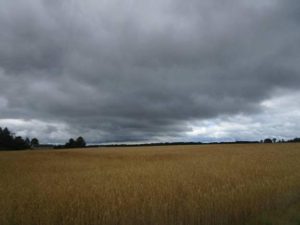
A rainy day begins to clear at a farm on Plainsboro Road in Cranbury, Middlesex County.
IN THE GARDEN: Harvesting-wise, the garden has slowed down, with the lettuce taking on a bitter taste, suggesting it is done for the cool season. I will plant more lettuce later in the summer for the fall season. Otherwise, I wait for tomatoes, corn, and cantaloupe. I do not know what happened to my cucumbers, except that I cannot find any growing. So, again, it is the three Ws: Water, Weed, and Wait. But the big discovery, or re-discovery, was the tomatillo plants growing, and fruiting, in the garden. I never planted them, but, for at least three gardening seasons, there they are. So, add them to my future harvest.
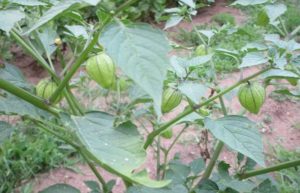
Tomatillos, which I never planted, fruiting in the garden.
AROUND THE YARD: I try to observe, whether it be looking around the yard or the sky (both night and day). As the week wrapped up and I was in the garden, I saw a red-tailed hawk, “Buteo jamaicensis,” soaring over the neighborhood. The Knock Out roses continue blooming nicely, the second bloom of the season. And I am visited by rabbits, probably “Sylvilagus floridanus,” and one of my favorites in wildlife, the catbird, “Dumetella carolinensis.” A catbird, unsure if it is the same one, keeps me company in the yard, whether I am gardening or simply hanging out.

A red-tailed hawk soaring over the neighborhood.
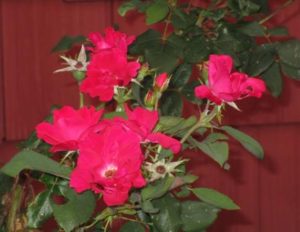
The yard’s Knock Out roses are in their second bloom of the season.
PINE BARRENS AROUND HELMETTA: Over the week, I walked afield only once and briefly. But I am around the wilds and drive paved roads through them daily. And I keep the camera at hand. I photograph a lot in a capture-the-moment way. So, I avoid using a cellphone, because it takes too long to unlock and it is too difficult to maneuver one-handed, instead using a point-and-shoot camera. I keep the camera at the ready — on the dashboard of my Jeep or, when I am doing yard work, in my pocket. Alas, this week, I was driving, I could not stop the Jeep, grab the camera, and focus the camera quickly and properly, missing a good photo of a group of turkeys, “Meleagris gallopavo,” with a deer, “Odocoileus virginianus,” in the background, around a woodpile as I drove past a house in the woods of Jamesburg Park. But I did photograph the turkeys and deer separately.
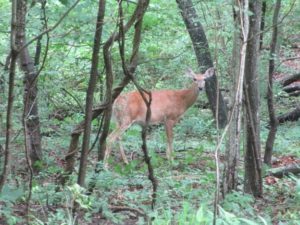
The deer in the Jamesburg Park section of East Brunswick.
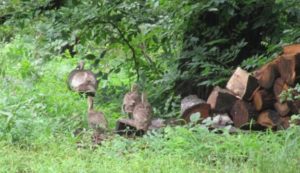
The Jamesburg Park turkeys.
WATERING THE GARDEN: I continue to obsess over watering the garden. This year, I have avoided “brown water,” or already used water such as bath water. Instead, I use freshwater, a combination of house system water, water from Manalapan Brook, captured rain water, and water from the cellar de-humidifier. I water daily, always before 10 a.m. so water is not lost to evaporation in the heat of the day and leaving the day for the plants and soil to dry, keeping fungus away. Now, I am considering watering fewer times a week, but in heavier doses. Friend, gardener, and environmental scientist Virginia Lamb had these thoughts, “I only water maybe twice a week and directly on plants, individual or rows. Probably roughly 2 quarts per plant. … Also you need to add mulching to your list of three Ws. …It will help retain moisture and keep weeds down. Also, add compost to the soil.”
EBONY JEWELWING AT THE BROOK: Manalapan Brook, which my family through my maternal side has lived along more than 100 years, runs about 400 feet from my front door. I regularly take a walk across the street and head to the Brook at the edge of the woods. This week, I encountered one of my favorite wildlife species, the ebony jewelwing damselfly, “Calopteryx maculate” – a beautiful combination of neon green and deep black. Two were flying around. I was hoping at least one would land on my outstretched arm, but not on this day. Eventually, I grabbed a bucket of water for my garden and went back home.
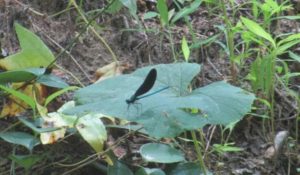
An ebony jewelwing rests along the bank of Manalapan Brook.
DAMSELFLY OR DRAGONFLY: When I was visiting Manalapan Brook, I also saw a dragonfly. What kind? I do not know. But I knew it was a dragonfly because at rest, its wings were like those of an airplane, parallel to the ground. A damselfly rests with its wings perpendicular to the ground.
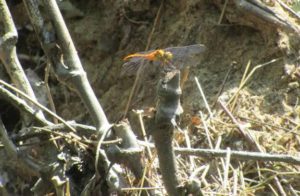
A dragonfly on the bank of Manalapan Brook.
SPOTSWOOD LAKE: Spotswood Lake, also known as DeVoe Lake or Mill Lake, is formed by the damming of Manalapan Brook. I happened to be at Spotswood Lake this week when the moon rose above it early in the night. So, there was a nice combination of the moon and soft sunlight.

The moon over Spotswood Lake.
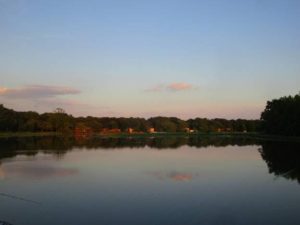
Soft sunlight on Spotswood Lake.
BALD EAGLES: I saw a Facebook report of a bald eagle, “Haliaeetus leucocephalus,” on road kill in Jamesburg. Debbie Sullivan Farrell reported, “Did anyone else see the eagle by the rescue squad at 9:50 this morning? I turned onto Gatzmer from Hillside and was going towards the tracks. An eagle was checking out some road kill and flew off towards the firehouse. It was huge!!! Then I saw the unmistakable white head. It was about 20 feet from me. It was an amazing sight.” The state Department of Environmental Protection 2016 bald eagle nest summary, http://www.conservewildlifenj.org/downloads/cwnj_736.pdf. Bald eagles are “endangered” (in immediate peril) as breeders and “threatened” (could become endangered if conditions persist) as non-breeders. In 1982, there was only one bald eagle nest in New Jersey; Last year, there were about 150.
GROVERS MILL: Does the name of this village in West Windsor, Mercer County, sound familiar. Well, it was the site of the Martian landing in the 1938 radio play adaptation -– by Orson Welles and the Mercury Theatre on the Air — of H.G. Wells’s novel, “The War of the Worlds.” Here is the broadcast that scared the country, https://www.youtube.com/watch?v=Xs0K4ApWl4g. Here is the story of the “panic broadcast,” http://www.smithsonianmag.com/history/infamous-war-worlds-radio-broadcast-was-magnificent-fluke-180955180/.
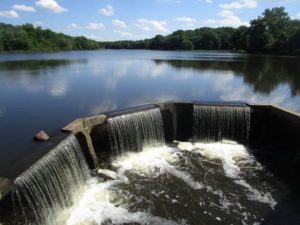
A view of Grovers Mill Pond from the spillway. The Pond is formed by the damming of Bear Brook.
RECORD GARDEN THOUGHTS: As I work the garden, I have thoughts on how I can improve it in 2018. I likely will not simply remember these ideas, so I am writing them down – things such as rotating crops, keeping only a lawnmower’s width between rows, maybe doing less space between plantings, and so on.
“FALL FOLIAGE” IN THE PINE BARRENS: Summer lovers, you probably do not want to hear about colder weather coming. But those of you venturing into the Pine Barrens, start looking for the changing colors of leaves in the swamps – up here in the Pine Barrens around Helmetta, roughly between July 15 and 31; maybe a week or two later in the main Pine Barrens to the south.
SEX!!!: Last week’s photo of the man turtle loving the woman turtle seems to have recharged the batteries of some readers of Garden and Afield. One woman emailed, “Love that perched turtle.” But this is my favorite e-mail exchange:
“You men love to watch herpetological porn!,” she said. “I’ve seen more pictures of snakes and turtles mating. LOL. Goes across species boundaries.”
“Baptist girls know about herp porn????” I replied.
“I do not seek out frog, turtle or snake porn!” – a likely story.
“It arrives on my desk via studies on sites like the Stafford Business Park, where the native northern pine snakes there were monitored for seven years via radio telemetry,” she continued. “The largest amount of notes was always on how much each individual male scored each season with which female. LOL. Pages and pages and pages of data and photos.”
Uh, she is an environmental scientist who studies herpetological pornography for a living….
SUNRISE/SUNSET: For July 9, Sunday, to July 15, Saturday, the sun will rise at about 5:35 a.m. to 5:40 a.m. and set about 8:25 to 8:30 p.m.
WEATHER: The National Weather Service forecasting station for the area is at http://www.weather.gov/phi/.
CORRECTION/CLARIFICATION: In the 2017, June 4 to 17, issue of Garden and Afield, I referred to a rabbit in the yard. I, likely, had the wrong scientific name. The correct scientific name probably is “Sylvilagus floridanus,” the eastern cottontail.
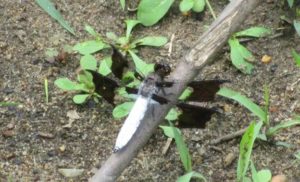
Some kind of dragonfly in the garden.
Joe Sapia, 60, is a lifelong Monroe resident. He is a Pine Barrens naturalist and an organic vegetable-fruit gardener.
He gardens the same backyard plot as did his Italian-American father, Joe Sr., and his Polish-immigrant, maternal grandmother, Annie Poznanski Onda. Both are inspirations for his food gardening. Joe is active with the Rutgers University Master Gardeners/Middlesex County program. He draws inspiration on the Pine Barrens around Helmetta from his mother, Sophie Onda Sapia, who lived her whole life in these Pines, and his Grandma Annie. Joe’s work also is at @JosephSapia on Twitter.com, along with Facebook.com on the Jersey Midlands page.





























































